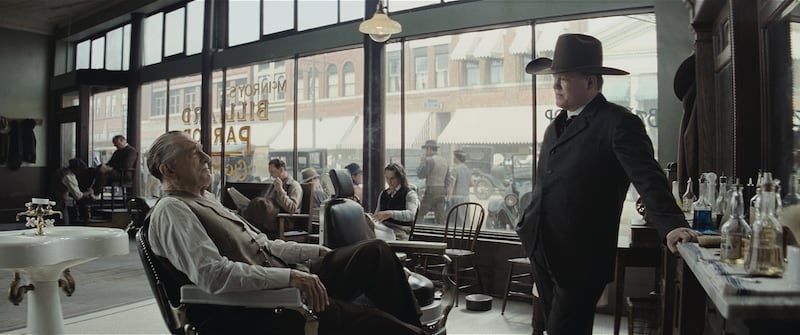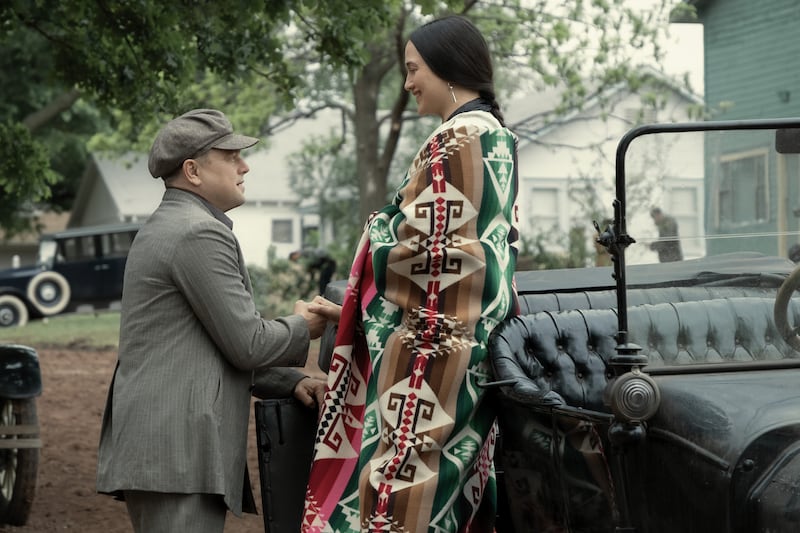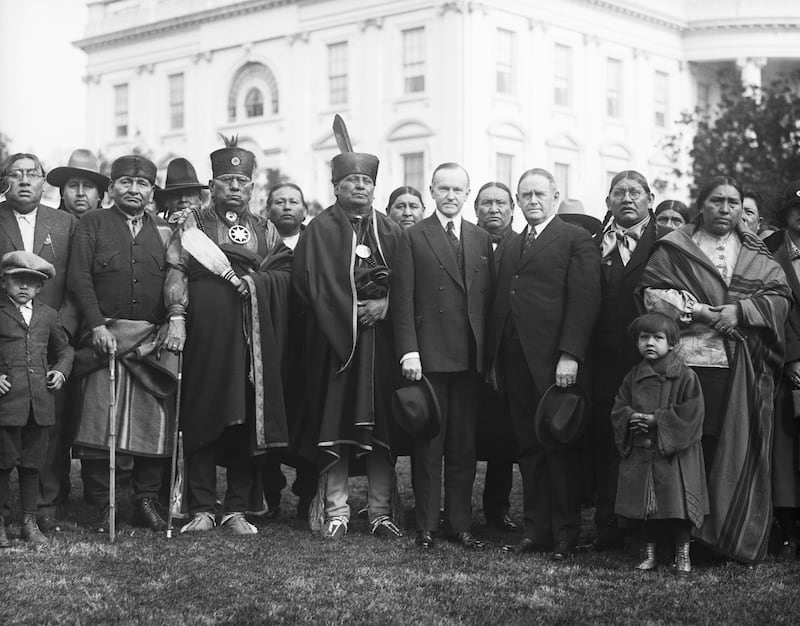Martin Scorsese has worked in, and often reinvented, every genre in film, testing the boundaries of the musical (New York, New York), the biblical epic (The Last Temptation of Christ), the comedy (The King of Comedy), the thriller (After Hours) and the biopic (Raging Bull) until each unmistakably resembles a Scorsese picture.
Well, almost every genre. At 80, the director has finally circled back to the genre that has shaped his film-making more than any other: the western. It’s a subject on which he talks fast. And a lot.
“I grew up on the American genres of the 1940s and 1950s,” he says. “I had asthma as a child. I couldn’t do any athletics, I couldn’t go near animals, I couldn’t go outdoors and be around vegetation because I got attacks. So, for me, seeing westerns, either in colour or black and white, was a major fantasy outlet. Growing up, I watched all the different aspects of the westerns, particularly John Ford’s films, Howard Hawks’s character-driven westerns, the psychological westerns of Anthony Mann, the westerns that showed respect for indigenous people by Delmer Daves — Broken Arrow, The Last Wagon.
“As a kid aged nine or 10, I thought everything was settled. It wasn’t until 1974 [that] I happened to visit the Pine Ridge Reservation in Dakota; I was very shocked and disturbed by the poverty and the conditions in which the Oglala Sioux were living. It was traumatic. I realised that there was much more going on than the mythology that we were fed. You know, I always wanted to make a western, but I thought the western genre really ended with Sam Peckinpah and The Wild Bunch. The western became something else, something about form, something that doesn’t reflect the values of America today.”
Scorsese happened upon David Grann’s book Killers of the Flower Moon: The Osage Murders and the Birth of the FBI as he wrapped Silence, his Jesuit missionary drama from 2016. Grann’s painstakingly researched work chronicles a horrific secret campaign waged against the Osage Nation in the 1920s after the discovery of oil deposits under their barren Oklahoma reservation briefly made the tribe the wealthiest people in the world; their fortune precipitated a series of mysterious murders.
[ Killers of the Flower Moon by David Grann: The calamity of the Osage oilOpens in new window ]
Scorsese immediately wanted to bring this “terrible tragedy unknown outside tribal peoples” to the big screen but wasn’t initially sure how. Early drafts of the script cast Leonardo DiCaprio as the FBI agent who comes to Oklahoma to investigate.
“Myself and [my co-screenwriter] Eric Roth talked about telling the story from the point of view of the bureau agents coming in to investigate,” says the director. “After two years of working on the script, Leo came to me and asked, ‘Where is the heart of this story?’ I had had meetings and dinners with the Osage, and I thought, Well, there’s the story. The real story, we felt, was not necessarily coming from the outside, with the bureau, but rather from the inside, from Oklahoma.”
In May, when Killers of the Flower Moon premiered at Cannes, the principal chief of the Osage Nation, Geoffrey Standing Bear, appeared on the red carpet alongside Scorsese. “On behalf of the Osage,” he said, “Marty Scorsese has restored trust. And we know that trust will not be betrayed.”

That trust began in 2019, when the film-maker met about 300 members of Oklahoma’s Gray Horse community. An unprecedented collaboration ensued. “I always said if I ever get involved with anything that has to do with indigenous people, I’d better know who the people are or, at least, feel comfortable with them as human beings,” says Scorsese. “And that’s what happened. When I first met Chief Standing Bear I was nervous. We went into his office. We started talking. I think what he needed from me was to know that I wasn’t going to take advantage of him, that I wasn’t going to sensationalise the story, particularly the victimisation of the Osage, particularly the violence.
“I know that a number of the people in the community pointed out that they had seen the movie Silence. They felt that a heart was there. I say this hesitantly. But they felt that they could trust white. I tried to do my best to come up to that trust — it was not easy. But it was very comfortable working with them. I depended on them. They’d tell me something; I’d write it down and put it in the script.”
Scorsese’s Killers of the Flower Moon pivots around the marriage of Ernest Burkhart, a first World War veteran — played, after a switch of character, by DiCaprio — who has returned to the United States and to the employ of his scheming cattle baron uncle, William K Hale (played by Robert De Niro), whose plans may be being facilitated by the Ku Klux Klan and the Freemasons.
Urged on by Hale, Burkhart courts and marries an Osage heiress named Mollie Kyle (a mesmerising Lily Gladstone). While she and Burkhart build a life and have children together, some of her family are killed, horrifically, with no little assistance from Burkhart. “It’s not a whodunit,” Scorsese says. “We know exactly whodunit. The audience is way ahead of us.” The fortunes of the dead Osage women duly pass to their white, opportunistic husbands.

After Kyle and various elders visit Washington, DC, to plead with President Calvin Coolidge to intervene, a former Texas Ranger named Tom White (played by Jesse Plemons) arrives on behalf of the Bureau of Investigation, the 1930s precursor to the FBI.
“When I read the book I was fascinated by the kind of mentality these schemers had,” says Scorsese. “And the horrible beauty of that mentality is how they justified everything. They thought, ‘This culture is on the way out. They don’t know the value of money. We take advantage of them and they are fine with it.’ As De Niro says, ‘There’ll be an outcry when they are gone, but people will forget.’ That’s what happened.
“What I realised too was that guys like Bill Hale were operating like people I knew in the Lower East Side in New York when I was growing up. Only not as smart. Because, out there, you could do anything. And they did. You have the Klan and the Masons behind you. You could pretty much get away with anything, the way certain politicians feel that they can now.”
The casting of Lily Gladstone, who deserves to take home the best-actress Oscar next spring, has proved to be one of Scorsese’s best ideas. Her remarkable quiet nobility on screen is complemented by a textured family history: she is descended on her father’s side from the 19th-century Blackfoot chief Red Crow and on her mother’s side from the British prime minister William Gladstone.
“We need allies,” Gladstone said in Cannes, praising Scorsese, DiCaprio and De Niro. “Native people are used to having anthropologists coming in, curious about everything that we do. These artistic souls ... cared about telling a story that pierces the veil of what society tells us we’re supposed to care about. Who else is going to challenge people to acknowledge their own complicity in white supremacy? We’re speaking of the 1920s Osage community; we’re talking about the Tulsa riots. Why the hell does the world not know about these things? Our communities always have. It’s so central to how we understand our place in the world.”

De Niro has compared his character to Donald Trump. Scorsese acknowledges a through line between De Niro’s nefarious Bill Hale and Ethan Edwards, John Wayne’s compelling anti-hero in The Searchers, a film that has long been a cornerstone for the director. Paul Schrader’s script for Taxi Driver reworked John Ford’s 1956 film against a scuzzy New York backdrop; in Who’s That Knocking at My Door? Harvey Keitel discusses Ethan’s showdown with his Native American rival Scar; the final, pointedly dreary codas of The Wolf of Wall Street and Goodfellas echo the door-framed exile that closes Ford’s film.
“It’s one of my great favourites,” says Scorsese. “There are certain issues with it, like indigenous people played by white actors. The attitude towards the female and indigenous characters is very, very hard to take. But what’s really great about that film is Ethan Edwards. When the film came out, some critics loved Ford’s films but stopped at The Searchers. What was Ford doing with a character like that? But in 1956 he represented the world around us. He represented base racism. He doesn’t belong anywhere any more. He shoots the eyes out of a dead Native American to kill the soul of the man. You can see the incredible hatred on John Wayne’s face. All the fear of sexuality and the conflict of cultures. It’s a very brave presentation of the conflict in postwar America.”
Rather too much is made of Scorsese’s aversion to superhero films and the Marvelisation of the movieverse. It’s frequently overlooked that the veteran film-maker is as effusive about emerging talents as he is dismissive of corporatisation. As an executive producer he has, in recent years, ushered Antoneta Alamat Kusijanović’s Murina, Josephine Decker’s Shirley and Kornél Mundruczó’s Pieces of a Woman into cinemas.
Today he says that the director Ari Aster helped to inspire the tempo of Killers of the Flower Moon. That timing is crucial for a film that flies by even though it’s almost 3½ hours long. “I very much like the style and pacing of good horror films like Ari Aster’s Midsommar or Beau Is Afraid. The pacing of those films goes back to the B films of Val Lewton, Jacques Tourneur’s Cat People or I Walked With a Zombie. Just going a little slower. A little quieter. I was very concerned about allowing scenes that were not narrative into the story, scenes to do with the Osage culture — leaving in those scenes of custom, like the baby namings, the funerals and the weddings — so we could begin to understand a little more about the people. I felt confident that a lot of people would allow themselves to be immersed in the world of the film. One has to take these chances. At this age, what else can I do?”
Killers of the Flower Moon is in cinemas from Friday, October 20th, with previews on Thursday, October 19th
















